Download links
How to install Mastering Chess Strategy: A Guide for Strategic Success APK?
1. Tap the downloaded Mastering Chess Strategy: A Guide for Strategic Success APK file.
2. Touch install.
3. Follow the steps on the screen.
Description
Chess strategy is a multifaceted discipline that encompasses a wide range of concepts and principles aimed at achieving victory on the board.
One of the fundamental aspects of chess strategy is the concept of control over the center of the board.
The central squares—d4, d5, e4, and e5—are critical because they allow pieces to exert influence across the board, facilitating both offensive and defensive maneuvers. Controlling the center enables players to launch attacks more effectively while also providing a solid foundation for piece development. Another essential element of chess strategy is piece development.
In the opening phase of the game, players must prioritize getting their pieces into active positions where they can contribute to the overall plan. This involves moving knights and bishops to squares where they can control key areas of the board and support potential pawn advances. A common mistake among beginners is to move the same piece multiple times in the opening or to neglect developing minor pieces in favor of advancing pawns.
Such missteps can lead to a lack of coordination and create vulnerabilities that an opponent can exploit. Understanding these foundational principles is crucial for any player looking to improve their strategic acumen.
Key Takeaways
- Understanding the basics of chess strategy is crucial for developing a strong foundation in the game.
- Developing a strong opening repertoire is essential for gaining an early advantage and setting the tone for the rest of the game.
- Mastering tactical awareness and calculation is key to spotting opportunities and executing winning combinations.
- Creating and executing long-term plans is important for maintaining a strategic advantage and guiding the game towards a favorable outcome.
- Understanding the value of piece activity and coordination is essential for maximizing the effectiveness of your pieces and controlling the board.
- Adapting to different types of positions and game phases is crucial for staying flexible and adjusting your strategy to the changing dynamics of the game.
Developing a Strong Opening Repertoire
A well-structured opening repertoire is vital for any chess player aiming to compete at higher levels. The opening phase sets the tone for the entire game, and having a solid repertoire allows players to navigate this critical stage with confidence. A strong opening repertoire should include a variety of openings that cater to different styles of play, whether aggressive, positional, or tactical.
For instance, players who prefer sharp, tactical battles might gravitate towards openings like the Sicilian Defense or the King’s Gambit, while those who favor a more positional approach may opt for the Queen’s Gambit or the Ruy Lopez. In addition to selecting openings that align with one’s style, it is equally important to understand the underlying ideas and plans associated with each opening. This means not only memorizing moves but also grasping the typical pawn structures, piece placements, and strategic goals that arise from these openings.
For example, in the Sicilian Defense, Black aims to create an asymmetrical pawn structure that can lead to dynamic counterplay against White’s central control. By studying games played by masters in these openings, players can gain insights into common tactics and strategies that can be employed in their own games.
Mastering Tactical Awareness and Calculation

Tactical awareness is a cornerstone of effective chess play, as it allows players to recognize opportunities for immediate gain or threats that need to be addressed. Tactics often involve short-term calculations that can lead to material advantage or checkmate. Common tactical motifs include forks, pins, skewers, discovered attacks, and double attacks.
Mastering these motifs requires not only familiarity with them but also the ability to spot them in various positions during a game. Regular practice through puzzles and tactical exercises can significantly enhance a player’s ability to recognize these patterns quickly. Calculation is another critical skill that goes hand-in-hand with tactical awareness.
It involves envisioning potential sequences of moves and evaluating their outcomes. Strong players often engage in deep calculation, considering multiple variations before committing to a move. This process can be daunting, especially in complex positions where many factors are at play.
To improve calculation skills, players should practice visualizing moves without moving pieces on the board, which helps develop mental discipline and enhances one’s ability to foresee consequences. Additionally, analyzing one’s own games and those of stronger players can provide valuable insights into how tactical opportunities arise and how they can be effectively exploited.
Creating and Executing Long-term Plans
| Metrics | 2019 | 2020 | 2021 |
|---|---|---|---|
| Revenue Growth | 10% | 15% | 12% |
| Market Share | 25% | 28% | 30% |
| Customer Retention Rate | 85% | 88% | 90% |
| Employee Satisfaction | 75% | 78% | 80% |
While tactics often dictate immediate actions on the board, long-term planning is essential for achieving strategic goals throughout a game. A well-formed plan takes into account the strengths and weaknesses of both players’ positions and seeks to exploit them over time. For instance, if one player has a strong pawn structure while the other has weaknesses in their position, a long-term plan might involve gradually improving piece placement while targeting those weaknesses through pawn breaks or piece maneuvers.
Executing long-term plans requires patience and flexibility. As the game progresses, circumstances may change due to tactical skirmishes or shifts in piece activity.
This adaptability is often what separates stronger players from their less experienced counterparts; they can pivot when necessary without losing sight of their strategic goals. Moreover, understanding when to transition from a strategic phase into a tactical one is crucial for maintaining momentum and seizing opportunities as they arise.
Understanding the Value of Piece Activity and Coordination
Piece activity refers to how effectively pieces are positioned on the board to influence play. Active pieces control key squares, threaten opponent’s pieces, and contribute to both offensive and defensive strategies. Conversely, passive pieces are often relegated to less impactful roles, limiting their effectiveness in contributing to a player’s overall plan.
Recognizing the importance of piece activity is vital for any player seeking to improve their game; it often dictates the flow of play and can determine the outcome of critical moments. Coordination among pieces is equally important in chess strategy. Well-coordinated pieces work together harmoniously to create threats or defend against attacks.
For example, rooks on open files can support each other while pressuring an opponent’s position, while knights positioned centrally can control multiple squares and support pawn advances. Players should strive for harmony among their pieces by ensuring they are not only active but also working together towards common goals. This synergy can create powerful threats that are difficult for opponents to counteract effectively.
Adapting to Different Types of Positions and Game Phases

Chess positions can vary dramatically based on pawn structure, piece placement, and material balance, necessitating different approaches depending on the situation at hand. Players must be adept at recognizing these variations and adjusting their strategies accordingly. For instance, in open positions where pawns are few and pieces have greater mobility, tactical opportunities abound, making it essential for players to remain vigilant for potential combinations and threats.
Conversely, closed positions often require a more strategic approach focused on maneuvering and gradual improvement of piece placement. In such scenarios, players may need to create weaknesses in their opponent’s pawn structure or find ways to open lines for their pieces through pawn breaks. Understanding these distinctions allows players to tailor their strategies effectively based on the specific characteristics of each position they encounter.
Moreover, adapting one’s approach based on the phase of the game—opening, middlegame, or endgame—is crucial for success in chess. Each phase has its own set of principles and strategies that must be understood and applied appropriately. For example, in the endgame, king activity becomes paramount as players strive to promote pawns into queens while simultaneously preventing their opponent from doing so.
Recognizing when to transition between these phases and adjusting one’s strategy accordingly is a hallmark of strong chess play. In conclusion, mastering chess strategy involves a comprehensive understanding of various elements ranging from basic principles to advanced concepts like long-term planning and tactical awareness. By developing a robust opening repertoire, honing tactical skills through practice, creating effective long-term plans, valuing piece activity and coordination, and adapting strategies based on position types and game phases, players can significantly enhance their performance on the chessboard.
Each aspect contributes uniquely to a player’s overall understanding of the game and their ability to navigate its complexities with confidence and skill.
If you’re a fan of strategy games like chess, you may also enjoy reading about the benefits of playing Garena Free Fire. This article discusses how the popular battle royale game can improve cognitive skills and decision-making abilities, much like chess does. Check out the full article

Facebook comments